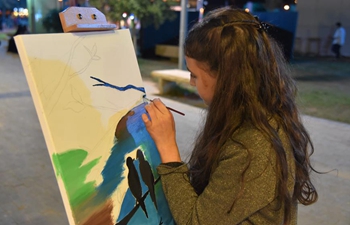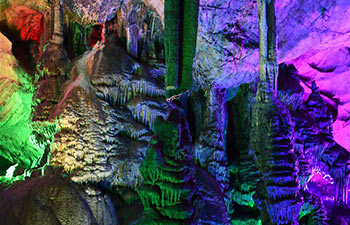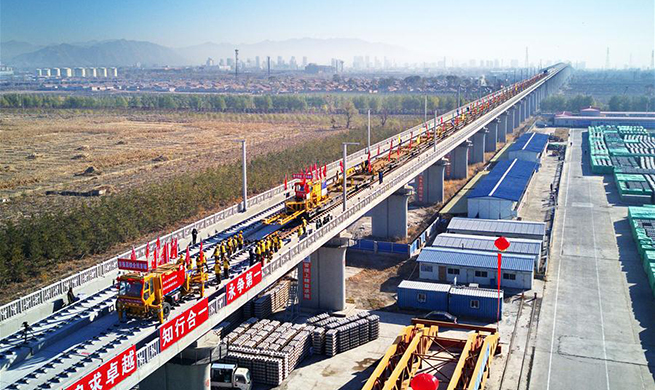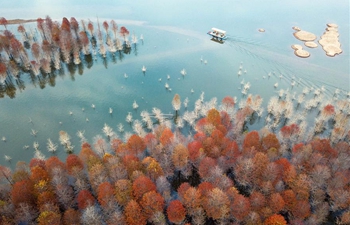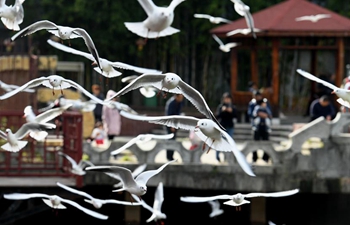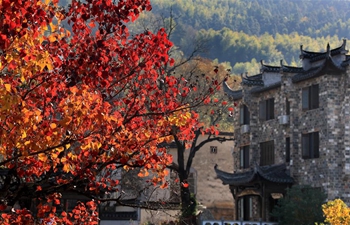by Xinhua writers Liu Fang, Dong Chen
AMSTERDAM, The Netherlands, Oct. 31 (Xinhua) -- Amsterdam court judges said Wednesday that they expect to render judgement on Dec. 12 over the mummy Buddha statue case in which inhabitants of two Chinese villages argue that the Dutch collector was in bad faith when he bought the statue stolen from their village temple in the 1990s and subsequently made it away through an oral exchange deal when legal procedures started over two years ago.
"The court will render a judgement in six weeks, on Dec. 12, if it is possible," said J. Thomas, one of the judges, after the hearing that lasted nearly three hours.
In May 2016, two villages in China's southeastern province of Fujian filed this repatriation case of religious, cultural and ethical significance against Amsterdam resident Oscar van Overeem. They said the statue van Overeem lent for an exhibition in March 2015 was the one their villages had worshipped for over 1,000 years before it was stolen from the village temple in December 1995.
Van Overeem agreed that the statue comes from Fujian Province, but insisted that it is not the Zhanggong Zushi, or Monk Master Zhang Gong, as the villagers claimed. He said that his statue had been bought before the villagers found that their Buddha had been stolen, and it doesn't have two specific physical features that the villagers attributed to theirs.
Van Overeem also stated that he had reached an oral deal and exchanged the statue for another artwork with a Chinese "collector-investor-intermediary," who "was aware of the mummy controversy and political sensitivities and therefore preferred to remain anonymous."
Both the villagers and the defendant have submitted several rounds of written statements and evidence to the court. Before the hearing Wednesday, the villagers submitted an investigation report by the Fujian Relics Authentication Center dated April 28, 2018, which, according to Jan Holthuis, the Dutch lawyer representing the villagers, "sets out in a very structural and detailed way why the VO (Oscar van Overeem) statue is the villagers' statue."
"We specifically pointed out the additional evidence provided in this investigation report, such as the Chinese characters on the back of the statue and on the basket that is in the village's possession, written by one and the same villager. The judge should now deal with this specific evidence, as it has formally become part of the court case file," Holthuis told Xinhua.
The Dutch collector stressed during the hearing that his statue does not have "a hole drilled in the left hand," and "its head is not loose at all," contrary to what some villagers had said. He supported his argument with an expert conclusion of CT scans of the statue.
The villagers' lawyer told the court that the source material of the CT scans needs to be examined by independent experts, not only by parties appointed by van Overeem.
Regarding the time he bought the statue, van Overeem repeated that he has no document of the purchase. He added that he would ask the person involved in the deal, who might have kept the 1995 sales documentation.
The Dutch collector also insisted that he is no longer in possession of the statue and does not have much information about the "third party" who had allowed him to exchange the statue for another artwork.
After the previous hearing on July 14, 2017, the court had granted permission for a motion filed by the villagers to preserve evidence by seizing certain specifically defined data from van Overeem's computer. These data are now in the hands of a third independent party.
The villagers' lawyer pointed out to the court hearing that the defendant had given inconsistent statements on the completion date of his so-called "exchange deal," insisting that the plaintiffs should have access to the person in the exchange deal in order to get back the statue.
"This claim against VO to disclose the third party's name is now part of the Dutch legal proceeding and court judges' deliberation before they make a judgement," Holthuis told Xinhua.
The Dutch lawyer said the judges will make up their minds on whether they think the statue is indeed Zhanggong Zushi, and which party shall bear the burden of proof.
For Liu Yushen, a Beijing-based Chinese lawyer who is assisting Holthuis in the Dutch legal proceeding, said it is normal that this kind of case will take a long time.
"The case is complicated, not only because it involves two different legal systems, but also because of the difficulties coming from non-legal factors. It's more about history, culture, religion, etc.," Liu said.
Six villagers, who arrived in Amsterdam on the eve of the hearing, were not questioned by the judges during the court hearing. However, their presence at the hearing was important in the view of their legal representative.
"Now the judges are aware that the villagers exist. The fact that they appeared in the Dutch court shows respect for the Dutch court and the judges," said Holthuis.
"And judges can get a feeling of what kind of people these villagers are," he added.
"VO has been discriminating against the villagers, saying they are emotional and upset, and they are trying to use government power to get their statue back. This story can no longer hold now because judges have seen it is not true," Holthuis added.

